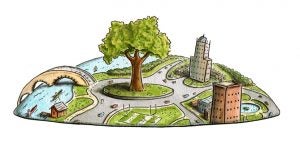
Improving your health can be as simple as choosing to walk to work or to take the stairs instead of the escalator. However, stairs are not even a viable option in some buildings and for some people it is not feasible to walk or bike to work. This blog post examines how public health is impacted by the way a community is designed.
The built environment (the structures and surfaces that make up a community) can negatively impact physical and mental health. Americans are suffering from increasing rates of noncommunicable diseases (NCDs), such as heart disease, cancer and diabetes. Much of this is due to lifestyle choices and the built environment, which, in many communities discourages walking. Studies show that the built environment can negatively impact mental health as well, causing stress, anxiety and depression, among other things.
According to the CDC, more than 1 in every 10 premature deaths in the United States can be explained by a lack of physical exercise. The CDC recommends that adults ages 18-64 get at least 150 minutes a week of moderate-intensity physical activity (such as brisk walking) or 75 minutes a week of vigorous-intensity physical activity (such as jogging or running), but less than half of Americans actually meet these recommendations. Sitting for 8 or more hours a day has been shown to nearly double the risk of Type 2 diabetes and drastically increases the risk for heart disease, cancer and premature death. The average American sits more than 9 hours a day.
Incidences of many NCDs can easily be decreased by encouraging people to exercise more. This can be done by changing the built environment to make cities more pedestrian and cyclist friendly. Oftentimes simple changes in zoning laws can make a city more walkable. For example, locating stores, worksites, public transportation, essential services and schools within short walking distance to residences and building and maintaining sidewalks or paths between destinations that are well-connected, safe and attractive will increase the likelihood that people will walk to their destinations. Studies show that wider streets encourage drivers to speed. Creating narrower streets and adding parking spaces as a buffer between streets and sidewalks creates a safer environment for pedestrians and encourages physical activity. These changes can save cities money by decreasing incidences of NCDs and thereby cutting health care costs.
Similar changes can be made to buildings. For example, making stairs (as opposed to escalators) more visible and accessible encourages people to take the stairs thereby helping to increase exercise and decrease incidences of heart disease, diabetes and other NCDs. Employers will be incentivized to do so because healthier employees bring down costs of health insurance in the long-term. Alternatively, single floor homes are more suitable for people with disabilities and the aging population. Some disabilities can actually be improved over time by staying active, and buildings and homes that are conducive to the needs of these populations can help.
Similarly, changes in landscape and design can impact mental health. For example, designing buildings so that people have more access to sunlight, both in their homes and offices, can decrease stress and depression. Further, creating more green spaces with trees and grass can positively impact mood and lead to increased mental health.
People make choices each and every day regarding their health. Some people choose to walk or bike to work instead of driving. Others do not have that option due to disability or location. When given the option between stairs and escalators some people choose the stairs. Either way, the built environment impacts physical activity, mood and thereby physical and mental health, and the way we think about this relationship will have an impact on the future design and zoning of cities.




